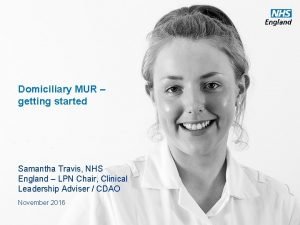Domiciliary MUR getting started Samantha Travis NHS England








- Slides: 8

Domiciliary MUR – getting started Samantha Travis, NHS England – LPN Chair, Clinical Leadership Adviser / CDAO November 2016 www. england. nhs. uk

Domiciliary MUR – getting started • Read service specification • Complete the SLA sign up sheet and return to NHS England • Return to sianrowbotham@nhs. net at Birch House • Inform indemnity insurer (good practice) • Ensure you have had a DBS check in last two years • NHS England issues letter of authorisation to the pharmacist www. england. nhs. uk 2

Ready to go……? Approach eligible patients; • Registered with a Derbyshire or Nottinghamshire GP • Agrees to pharmacist visiting at home (not care homes) • Taking 6 or more medicines for one or more long term condition • Housebound patients only please! • Send PREM 2 form to sianrowbotham@nhs. net www. england. nhs. uk 3

Arrange appointments (Max 10) • The person’s GP should be contacted first to confirm that there are no known risks • Contact by telephone or letter and the medicines use review explained. • A suitable time should be arranged for visit • Inform pharmacy team of the time, location and expected duration of the MUR. • Take a mobile phone • Smart cards should be used as ID, along with a letter of authorisation from NHS England, which should be shown to the person before entering their home. www. england. nhs. uk 4

The visit • Provision of the MUR at person’s home • Complete standard PSNC MUR form / GP follow up form • Claim £ 28 fee via FP 34 in usual manner • Undertake additional assessment & record on Pharmoutcomes • Triggers MUR fee and additional payment of £ 56 (no other paperwork to complete) www. england. nhs. uk 5

Additional assessment (1) Aims to; • 1. Identify any issues the patient has in accessing their medicines – ordering and collecting prescriptions • 2. To identify any physical issues that impact on their ability to take their medicines and minimise these by changing either formulation, packaging or labelling, or provision of an aid such as an eye drop dispenser or spacer • 3. To assess any compliance aids currently used by the patient to help them to remember to take their medicines and to identify and provide any support to assist with this such as reminder charts, medicine administration records. • 4. To determine if the patient is eating normally or has had a recent assessment for ongoing need of sip feeds. If eating normally sip feeds should be stopped • 5. To remove with permission any medicines no longer needed by patient and dispose of in line with PSNC guidance www. england. nhs. uk 6

Additional assessment (2) • Project uses RIO scoring system - classifies intervention according to the likely effect the intervention has on preventing a hospital admission. • RIO 1 = no likelihood of emergency hospital admission prevented • RIO 2 = possible prevention of emergency hospital admission • RIO 3 = likely to prevent an emergency hospital admission • Enables a quantitative evaluation of this project in relation to patient outcomes • Record on Pharmoutcomes – increases chance of future commissioning www. england. nhs. uk 7

More sir? • If you would like to do some more domiciliary MURs contact samantha. travis@nhs. net • Any questions? www. england. nhs. uk 8















